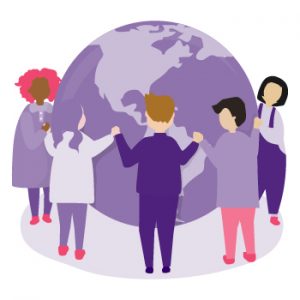
World Living Languages
Introduction
Sovereignty brings the right of autonomy (self-rule) and autonomy brings forth the opportunity to choose the official and national language of the country. Due to this, different countries have had different languages. Not to neglect the fact that languages sometimes not only belong to a particular country but to a particular geographical territory. People consider them among the world living languages.
The main source of communication is language. It can either be written and verbal. Without language, people would not be able to communicate. Since the beginning of life on Earth, people simultaneously invented languages and discontinued their use. Initially, they tied knots in ropes in a specific pattern to communicate with each other.
People discontinued this method of communication and stepped up at verbal communication. To understand each other better. This compilation of words formed the World’s first language. As the human population quickly grew, they divided themselves into tribes. These tribes later became independent nations.
The leaders of these nations would attack and invade the neighboring nations and tribes to expand their territories. These invasions marked the death of the native languages of those territories and caused the introduction of new and foreign languages. This whole scenario has continued ever since.
Many languages were discontinued due to a few or none of their speakers left. Some of these languages survived. People term them as “Living languages”. There are not only written or spoken languages but also gestural language (sometimes called sign language).


Sign language involves the voluntary movement of body parts by an individual to convey a message to another. Gestural language involves body actions. People use it to exchange ideas and messages with other people who have a hearing impairment or a speech impairment.
Along with some other languages, sign language is also a living language. Let us investigate some of the World’s Living Languages.
Unfolding
The Human race has used about thirty-one thousand languages since the beginning of the World but today only a few of them exist. According to Linguistic historians and linguistic experts, about six thousand and five hundred languages exist today.
What caused only six thousand languages out of thirty-one thousand to survive? Well, it is quite intriguing. The thing we mentioned here is “Language Death”. Language death is the discontinuation of a language until not a single human speaks it.
What is a Living Language?
A Living language is a language that outlives and survives the dominance of other languages. It is a language; a significant number of people still use for communication. “Modern language” is another term for living language. People use the term “Modern Language” in language education to refer to living languages that are used in everyday communication.
They use this term to differentiate classical dead languages such as Latin or Old Chinese, which Linguistic historians’ study for their cultural and linguistic value. There are about six thousand and five hundred languages that are still in use today.
What is a Dying Language?
A Dying language is a language that has few to zero speakers. It is a language that slowly fades away in the pages of history. Dying languages can be so classical and rich in cultural and linguistic values at one point in history but as new foreign languages dominated them, they slowly dissolved in the ocean of history.
Old Chinese and Classical Latin are good examples of a dying language. There have been about twenty-five thousand dead languages so far according to Linguistic historians.
Features of a Living Language
A living language should possess at least a few of the following characteristics:
- A living language should be arbitrary. There should not be any inherent relation between the words, their meanings, or the ideas that they convey. If a living language is not arbitrary, then it would not have any dialects.
- It should be vocal. A living language should be vocal language to make it able to survive. If it is just a gestural or sign language, then it may end up being faded from the chapters of history. It may become a dead language. The Egyptian Hieroglyph Language is a great example. The Hieroglyphs (pictorial symbols) still exist but many linguistic historians are unable to interpret their actual meanings.
- A living language should be productive and creative. It should also be rich in historical and cultural values. If it is not so, then it may attract very few speakers which automatically secures its chance to be an endangered language. There are 3,500-plus “endangered languages” currently.


- It should have the tendency to be developed and evolved. By the passage of time, its speakers should make language evolution and development to make it able to survive both the nearby and far future.
Difference between an Extinct and a Dead language
There is a quite significant difference between a living and a dying language but people often confuse the terms “Extinct language” and “Dead language”. An extinct language is a language that is completely forgotten and no longer used.
Whereas a dead language that is no longer spoken but still used for linguistic studies. An extinct language only has its name left whereas a dead language has some written contexts and spoken scripts. An example of a dead language is Latin whereas Aramaic is an example of an extinct language.
Some Important Living Languages
Here we have listed down some important modern languages that are widely spoken throughout the World. Most of these languages are business languages meaning people use them in business campaigns and meetings.
- English is among the compulsory languages that governments consider mandatory for formal education in many countries. It is also the most widely spoken foreign language among the other European languages and the official language of about 67 countries. The English language is the native language of England. English holds the position as the foremost world language.
- French is the official language of France and is also termed a Super central language.
- Spanish is also termed a Super central language. It is the native and the official language of Spain.
- The Arabic language is a Semitic language. It also enlists among the compulsory languages for both formal and informal education in the Arab world. Many Muslim countries outside the Arabic world, also consider it a compulsory language.
- The Chinese language is the second most spoken language worldwide. It is native to China and its dialect “Mandarin Chinese” is the most spoken of its kind.
Urdu-Hindi, Russian, Portuguese, and German are some other additional languages that are rapidly developing and amassing a large number of their speakers.
Modern Languages That You Must Learn
Some modern languages that you must learn to achieve success in your career and business are:
- The Dutch Language (The Netherlands is already the most stable economy in Europe.)
- The English Language (Of course, it is the most spoken language for a reason.)
- The Chinese Language (Due to China being on its way to becoming a Global power.)
Wrap up
Languages get lost and erased in the chapters of history but it is not always because of another foreign language. Sometimes, a language’s own dialect can overthrow the original language too just like Mandarin Chinese. But it all depends on us and our contributions to a language whether it be literary or evolutionary.



Sorry, the comment form is closed at this time.